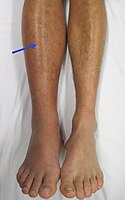
Photo from wikipedia
BACKGROUND Increased rates of thromboembolism (TE) have been reported in patients with COVID-19, even without prior predisposition to thrombosis. Cancer patients are already predisposed to a hypercoagulable state. This study… Click to show full abstract
BACKGROUND Increased rates of thromboembolism (TE) have been reported in patients with COVID-19, even without prior predisposition to thrombosis. Cancer patients are already predisposed to a hypercoagulable state. This study was designed to assess the TE incidence in COVID-19+ patients with active cancer and its impact on survival. METHODS Data from cancer patients with documented COVID-19 during the dates March 15th-April 10th, 2020, were retrospectively reviewed. Active cancer was defined as disease treated within the past year. Diagnosis and evaluation of thrombosis were done at the clinicians' discretion. All imaging studies' reports within 30 days of the COVID-19 positive test were reviewed for identification of new arterial and/or venous TE. Patients were followed for 30 days from the date of COVID-19+ test for development of TE, hospital length of stay (LOS), and mortality. RESULTS Of 90 patients, 11 (12.2%) were found to have 13 new TE within 30 days of COVID-19+ test: 8 (8.9%) arterial and 5 (5.6%) venous. Arterial TE was primarily new strokes and/or microvascular cerebral disease (7) with 1 splenic infarct. Venous TE was superficial (1) and deep (3) venous thromboses with 1 pulmonary embolism. Peak D-dimer (DD) values were numerically higher in the TE group versus those with no TE, median peak DD, 7.7 versus 3.2 μg/mL, p = 0.25. Kidney disease was more frequent among patients with TE (72.7%) versus those without TE (31.6%), p = 0.02. Prophylactic or therapeutic anticoagulation (AC) in the inpatient setting was more common among those without TE, any AC, TE versus no TE, 9.1% versus 79.0%, p < 0.0001. Only 1 patient on enoxaparin prophylaxis developed TE. Mortality was higher in the TE group than in those without TE (hazard ratio: 2.6; 95% CI [1.2-5.6], p = 0.009). Cancer type, presence of metastases, administration of prior chemotherapy, patient setting (inpatient, intensive care unit, outpatient, emergency department visit), LOS, and ventilation did not correlate with increased incidence of TE. CONCLUSION Cancer patients with COVID-19 have high overall TE rates with a significant incidence of arterial events. TE was associated with worse survival outcomes.
Journal Title: Acta haematologica
Year Published: 2021
Link to full text (if available)
Share on Social Media: Sign Up to like & get
recommendations!